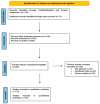Gut Microbiome Dysbiosis and Its Impact on Reproductive Health: Mechanisms and Clinical Applications
- PMID: 40559414
- PMCID: PMC12195147
- DOI: 10.3390/metabo15060390
Gut Microbiome Dysbiosis and Its Impact on Reproductive Health: Mechanisms and Clinical Applications
Abstract
The human gut microbiome is integral to maintaining systemic physiological balance, with accumulating evidence emphasizing its critical role in reproductive health. This review investigates the bidirectional interactions between the gut microbiota and the female reproductive system, mediated by neuroendocrine, immune, and metabolic pathways, constituting the gut-reproductive axis. Dysbiosis, characterized by microbial imbalance, has been linked to reproductive disorders such as polycystic ovary syndrome (PCOS), endometriosis, infertility, impaired spermatogenesis, and pregnancy complications. These associations can be explained by immunological dysregulation, systemic inflammation, altered sex hormone metabolism, and hypothalamic-pituitary-gonadal (HPG) axis disturbances. This review aims to clarify the molecular and cellular mechanisms underpinning gut-reproductive interactions and to evaluate the feasibility of microbiome-targeted therapies as clinical interventions for improving reproductive outcomes.
Keywords: fertility; gut microbiota; hormone; immune system; inflammation; microbiota–gonadal axis.
Conflict of interest statement
The authors declare no conflicts of interest.
Figures



Similar articles
-
Effect of Exercise on Ovulation: A Systematic Review.Sports Med. 2017 Aug;47(8):1555-1567. doi: 10.1007/s40279-016-0669-8. Sports Med. 2017. PMID: 28035585
-
Synbiotics, prebiotics and probiotics for solid organ transplant recipients.Cochrane Database Syst Rev. 2022 Sep 20;9(9):CD014804. doi: 10.1002/14651858.CD014804.pub2. Cochrane Database Syst Rev. 2022. PMID: 36126902 Free PMC article.
-
Gut feeling: understanding the endometriosis-digestive link to enhance patient care and symptom control.Curr Opin Obstet Gynecol. 2025 Aug 1;37(4):285-293. doi: 10.1097/GCO.0000000000001041. Epub 2025 May 8. Curr Opin Obstet Gynecol. 2025. PMID: 40459422 Review.
-
The gut microbiota: a double-edged sword in endometriosis†.Biol Reprod. 2022 Oct 11;107(4):881-901. doi: 10.1093/biolre/ioac147. Biol Reprod. 2022. PMID: 35878972 Free PMC article. Review.
-
Gut microbiota dysbiosis -associated obesity and its involvement in cardiovascular diseases and type 2 diabetes. A systematic review.Microvasc Res. 2024 Jan;151:104601. doi: 10.1016/j.mvr.2023.104601. Epub 2023 Sep 9. Microvasc Res. 2024. PMID: 37690507
Cited by
-
Reproductive Health and Assisted Conception in Celiac Disease and Non-Celiac Gluten Sensitivity: A Narrative Review.Nutrients. 2025 Jul 3;17(13):2215. doi: 10.3390/nu17132215. Nutrients. 2025. PMID: 40647319 Free PMC article. Review.
References
-
- Schoultz I., Claesson M.J., Dominguez-Bello M.G., Fåk Hållenius F., Konturek P., Korpela K., Laursen M.F., Penders J., Roager H., Vatanen T., et al. Gut microbiota development across the lifespan: Disease links and health-promoting interventions. J. Intern. Med. 2025;297:560–583. doi: 10.1111/joim.20089. - DOI - PMC - PubMed
Publication types
LinkOut - more resources
Full Text Sources

